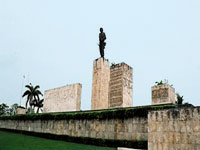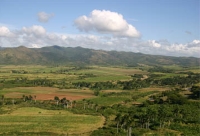
The soft sand and still, warm waters backed by palm trees make the beach at Playa Ancón a popular excursion from Trinidad. Situated at the end of the peninsula, seven miles (12km) south of Trinidad, Playa Ancón offers watersports and some good offshore snorkelling and diving sites. The colourful coral, rock tunnels and other exciting features of the seabed make this beach a scuba divers playground.Visitors can take a yacht out into the ocean for a swim, or hire boats to explore the coast or go fishing. The beach is famous among locals and travellers alike and the crowds there are a great mix of the two: it can be pleasant to go during the week when it is quieter; but, although it can get crowded during the weekend, it is quite fun watching the locals cavort and it is a good opportunity to mingle and meet people.Make sure to bring snacks or a picnic because food stalls at the beach are limited and the hotels along the beach front generally only cater for their guests. A lovely way to see the countryside is to cycle from Trinidad to this beautiful beach - passing through a picturesque little village on the way - which is not strenuous.
Address : Seven miles (12km) south of Trinidad

This neo-classical mansion belonged to one of the richest families in Cuba, the Borrell family, between 1827 and 1830 but it was bought by German sugarcane plantation owner Justo Cantero, a controversial figure in local gossip. The mansion, now a museum, is still called Casa Cantero.The grandiose house, just off Plaza Mayor, is in itself the main attraction, with beautiful wall murals depicting classical scenes and splendid decor in the rooms. Apart from the cool, stylish rooms, the museum also displays some exhibits relating to the sugar industry and history of Trinidad, including collections of weaponry, furniture, art and important documents.One of Casa Cantero's most popular attractions is the superb view that can be seen from the mansion's tower - from here you can see wonderful vistas of Trinidad and the Escambray Mountains. This view alone will more than justify the entrance fee for photographers. The museum starts getting crowded after 11am, when the tour buses arrive, so it is best to visit early in the morning to enjoy the charm of the place.
Address : 423 Simón Bolívar

Trinidad has a number of museums housed in colonial mansions, but one of the best is the beautifully renovated Museo Romántico overlooking the main square, Plaza Mayor. The Plaza Mayor is the historic centre of Trinidad and has been declared a UNESCO World Heritage Site. The mansions, or palaces, that surround the square date back to the 18th and 19th centuries when trade in sugar and slaves brought great wealth to the area.The Museo Romántico, or Brunet Palace, was built in 1812 by the wealthy Borrell family but it takes its name from the Brunet son-in-law who took over the house. The museum displays mostly the belongings and personal collections of these two grand families and boasts an excellent exhibition of paintings, decorative furniture and porcelain from the 1830s.The mansion itself is the main attraction, however, with the original marble floors still on display and splendid frescoes and neoclassical architecture and decoration. The Plaza Mayor is an un-missable attraction in Trinidad and visitors will do themselves an injustice if they don't explore some of these magnificent old houses, which provide so much insight into a certain period of Cuban history.
Address : Calle Echerri 52

The beautiful colonial city of Sancti Spiritus, with its gracious people, delightful architecture and maze of narrow, winding cobblestone streets, remains almost completely detached from the main tourist trail in Cuba. Located in the centre of the country, 43 miles (70km) east of Trinidad, Sancti Spiritus lies on the banks of the Yayabo River, exuding charm, affability and authenticity.The old town dates back to 1514 and has been declared a National Monument. It is filled with picturesque, colourful little houses with uneven red-tiled roofs and weathered colonial homes. It also boasts the much-photographed green-towered church which dates back to the early 16th century, making it the oldest church in Cuba. Streets are crammed with horse-drawn carriages, bicycles, scooters and pedestrians licking at ice-creams flavoured with a fruit which grows along the banks of the river. Spanning the river is the Puente Yayabo, an arched brick bridge built by the Spanish in 1815, and the city's most famous sight.The population of Sancti Spiritus is only about 100,000 and its rundown charm and friendly, laid-back people are part of its appeal. It is also renowned to be the home of many famous Cuban singers and musicians so it is worth seeking out some music when you visit.

Located 55 miles (88km) north of Trinidad, the city of Santa Clara is best known for its Che Memorial at the Plaza de la Revolución, and monuments relating to the Cuban Revolution. The armoured train monument (Monumento a la Toma del Tren Blindado) marks the spot where Che attacked the train, sending Batista's troops to Santiago de Cuba, a battle which was a decisive factor in the victory of the revolutionaries.The Ernesto Che Guevara Monument was built to pay homage to the memory of Che and his comrades who fought with him in Bolivia, and the enormous monument incorporates a huge statue of Che with his famous phrase Hasta la Victoria Siempre(Forever Onwards Towards Victory), as well as representations of many aspects of his revolutionary life.To one side of the statue, a huge stone block has been inscribed in full with his farewell letter to Fidel Castro. The monument also includes a mausoleum where the remains of Che and his comrades have been interred, and a museum with displays about his life and involvement in the revolution.

This picturesque emerald valley was once the centre of the sugar trade industry in Cuba, and home to the plantations that brought wealth and prosperity to Trinidad in the 18th and 19th centuries. At the peak of the sugar trade there were over 70 sugar cane mills in the valley area and about 30,000 slaves working on the plantations.Today, the ruins of estates, sugar mills and other remnants are visited by tourists who are attracted by the beauty of the valley and the historical significance of the slave trade that operated during the valley's boom years. The main site is the Manaca Iznaga, a striking 144ft (44m) high tower that was used by a plantation owner, one of the wealthiest men in Cuba, Pedro Iznaga, to keep watch over his slaves working in the fields. The bells in this tower would toll to signal the end of the working day. Visitors can climb the tower for impressive views over the countryside.Along with Trinidad, the Valle de los Ingenios has been declared a UNESCO World Heritage Site. Horse riding tours to the valley, departing from Trinidad, are a popular way to see the sights and take in the beautiful surroundings.
Address : Carretera de Sancti Spiritus (8km from Trinidad)

Travel Guide powered by Word Travels, copyright © 2023 Globe Media Ltd. By its very nature information in this travel guide is subject to change at short notice and travellers are urged to verify information on which they're relying with the relevant authorities. Neither Globe Media Ltd nor Travel Vogue can accept any responsibility for any loss or inconvenience to any person as a result of information contained above.